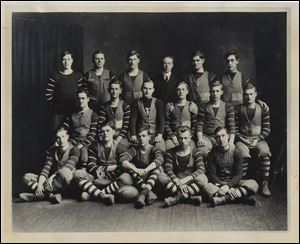
MONDAY MEMORIES
Gridiron beginnings for 1911 Toledo Maroons of the NFL
8/25/2014
Toledo Maroons, one of Ohio's "big name" football clubs of the formative years of the professional game (NFL), The Maroons were first organized in 1906. This portrait was taken of the 1911 team. From left to right Back row: Ray Bryan, Blade proof reader, Louis Kruse and John Schimmel, Art Gratop, Clude Chappel and Joseph Schimmel. Middle row: Rudy Lutz, Walter Matthews, Alvin Schmuhl, Louis Trout, Hugh Goodsite and Leslie West. Front Row: James Baxter, Robert Inglis, Walter Pfann, A. Gideon Spieker and Milton McGuire.
Nice uniforms these guys are sporting, right? In honor of the return of football season we turn the clock way back to one of the earliest pro football teams from Toledo.
This archive photo from The Blade shows the 1911 Toledo Maroons, one of Ohio’s “big name” pioneer clubs in the formative years of the National Football League. The team had such success that when the Pro Football Hall of Fame opened in Canton in 1963, assorted mementos of the Toledo Maroons were prominently exhibited.
Their uniforms consisted of deep red jerseys with white stripes on each sleeve. There was padding cross-stitched at the shoulders and reinforced leather pads sewn into the elbows. The pants were heavily padded, very large, and very loose.
The original Maroons were founded in 1906 as a “kid team” to help develop young high school players. But by 1910, the Maroons started rolling over local clubs such as the Overlands, Broadways, Riversides, and East Toledos.
During the following few years, the Maroons gained additional prestige by overpowering the strongest independents in northwestern Ohio and southern Michigan. They had no home field and played most of their games at East Side Central School, Ames Bonner Field at Phillips Avenue and the New York Central tracks, Brickyard grounds (the site of Waite High School), and the old Showgrounds on Dorr Street.
For road games the team traveled by interurban or horse and buggy, and it was lucky to earn $25 once travel expenses were factored in. Local players made $20 to $50 a game, while some of the Maroons’ imported stars could make $75 a game.
The Maroons attained powerhouse status among the major pro independents in 1914 and for the next three years saw tremendous success, defeating many of the finest pro teams of that era.
As their fame grew, so did the need for a larger field. They arranged for a lease on old Armory Park, which became the site of the Federal building on Spielbusch Street, and a local firm agreed to put up bleachers and a fence.
The Maroons charged 50 and 75 cents admission for most games, but were able to sell tickets for a dollar for some of the top match-ups against the Massillon Tigers, Canton Bulldogs, and Columbus Panhandles.
The informal Ohio grid circuit was the forerunner of the American Professional Football League, which was born at a meeting of 11 men in a garage in Canton in 1920. The league was later reorganized and became the National Football League.
The Toledo club disbanded at the outbreak of World War I.
Go to toledoblade.com/Memories to purchase photos by our award-winning staff of photographers, past and present.